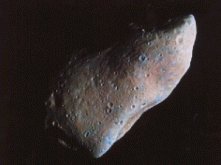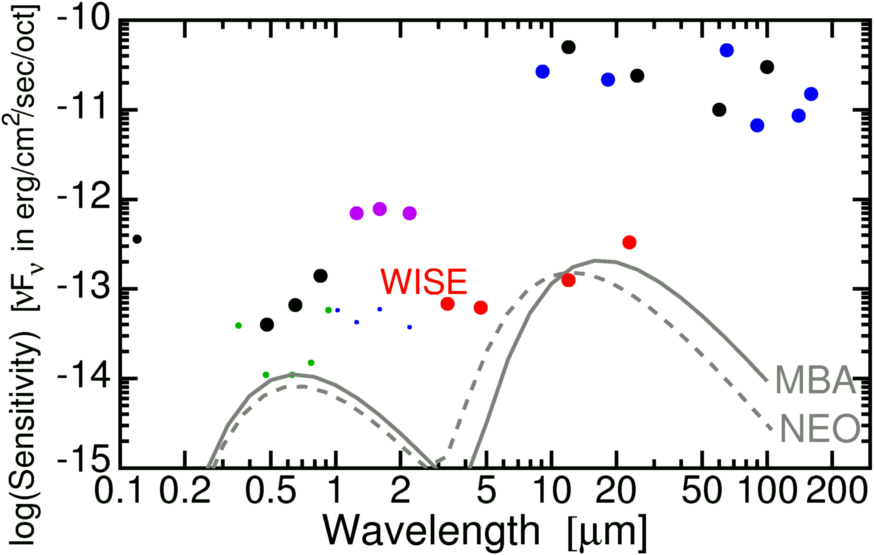WISE and Asteroids
 Asteroids are usually detected optically, but the typical asteroid is
quite dark and usually absorbs ten times more Solar radiation than it
reflects. The absorbed power goes into heating the asteroid, and this
heat is then radiated away as infrared radiation primarily in the 12 and
23 micron WISE bands.
As a result, WISE will be able to detect asteroids a million times
fainter than Ceres, the largest asteroid.
These faint small asteroids are not well catalogued, so WISE will provide a
vast database of new astrometric and radiometric information on
previously unknown asteroids.
The image on the right is the 19 km long main belt asteroid
Gaspra as seen by Galileo during a flyby.
Asteroids are usually detected optically, but the typical asteroid is
quite dark and usually absorbs ten times more Solar radiation than it
reflects. The absorbed power goes into heating the asteroid, and this
heat is then radiated away as infrared radiation primarily in the 12 and
23 micron WISE bands.
As a result, WISE will be able to detect asteroids a million times
fainter than Ceres, the largest asteroid.
These faint small asteroids are not well catalogued, so WISE will provide a
vast database of new astrometric and radiometric information on
previously unknown asteroids.
The image on the right is the 19 km long main belt asteroid
Gaspra as seen by Galileo during a flyby.

The figure shows the flux of a 1 km diameter main belt asteroid (MBA)
2.7 astronomical units from the Sun compared to the WISE sensitivity.
This asteroid would be a >5 standard deviation detection at 12 microns
after the >8 frames that should contain the asteroid are
appropriately stacked, so WISE data could be used to give radiometric
diameters for almost all asteroids with known orbits.
Bigger asteroids could be easily detected in single frames and thus WISE
will discover a large number of asteroids with diameters > 3 km.
 WISE will always be scanning about 90o away from the Sun and thus
will be quite good at detecting near Earth objects. The dashed curve
above is a 0.2 km diameter near Earth object (NEO) at a distance of
1 au from the Earth. It is easily detectable. The image at right
shows three frames from a radar
"movie"
of the 1 km size NEO 1998 WT24
rotating as it passed very near the Earth on 17 Dec 2001. WISE science
team member Bob McMillan leads the ground-based optical asteroid
survey Spacewatch,
which is engaged in searching for these NEO's and will followup some of
the more interesting WISE asteroid discoveries to provide accurate
orbits and albedos.
WISE will always be scanning about 90o away from the Sun and thus
will be quite good at detecting near Earth objects. The dashed curve
above is a 0.2 km diameter near Earth object (NEO) at a distance of
1 au from the Earth. It is easily detectable. The image at right
shows three frames from a radar
"movie"
of the 1 km size NEO 1998 WT24
rotating as it passed very near the Earth on 17 Dec 2001. WISE science
team member Bob McMillan leads the ground-based optical asteroid
survey Spacewatch,
which is engaged in searching for these NEO's and will followup some of
the more interesting WISE asteroid discoveries to provide accurate
orbits and albedos.
Because WISE will be so sensitive to asteroids, its scan pattern has been
designed to allow one to distinguish between asteroids and stars or
galaxies by looking for motion over the period of several hours to a day
spanned by the frames covering a given piece of sky.
The Spitzer Space Telescope
has observed fields on the ecliptic in the infrared and sees many asteroids.
The image below blinks between two epochs on a field in Taurus at 24 μm
which is very close to the WISE 23 μm band. The field of view is
quite close to the 47 arc-minute field of view of a single WISE frame.

These frames are correctly aligned even though most of the bright "stars"
are jumping back and forth. Most of the bright objects on the ecliptic in the
thermal infrared are asteroids!
WISE Home Page
Last modified 08 Mar 2010
 Asteroids are usually detected optically, but the typical asteroid is
quite dark and usually absorbs ten times more Solar radiation than it
reflects. The absorbed power goes into heating the asteroid, and this
heat is then radiated away as infrared radiation primarily in the 12 and
23 micron WISE bands.
As a result, WISE will be able to detect asteroids a million times
fainter than Ceres, the largest asteroid.
These faint small asteroids are not well catalogued, so WISE will provide a
vast database of new astrometric and radiometric information on
previously unknown asteroids.
The image on the right is the 19 km long main belt asteroid
Gaspra as seen by Galileo during a flyby.
Asteroids are usually detected optically, but the typical asteroid is
quite dark and usually absorbs ten times more Solar radiation than it
reflects. The absorbed power goes into heating the asteroid, and this
heat is then radiated away as infrared radiation primarily in the 12 and
23 micron WISE bands.
As a result, WISE will be able to detect asteroids a million times
fainter than Ceres, the largest asteroid.
These faint small asteroids are not well catalogued, so WISE will provide a
vast database of new astrometric and radiometric information on
previously unknown asteroids.
The image on the right is the 19 km long main belt asteroid
Gaspra as seen by Galileo during a flyby.


